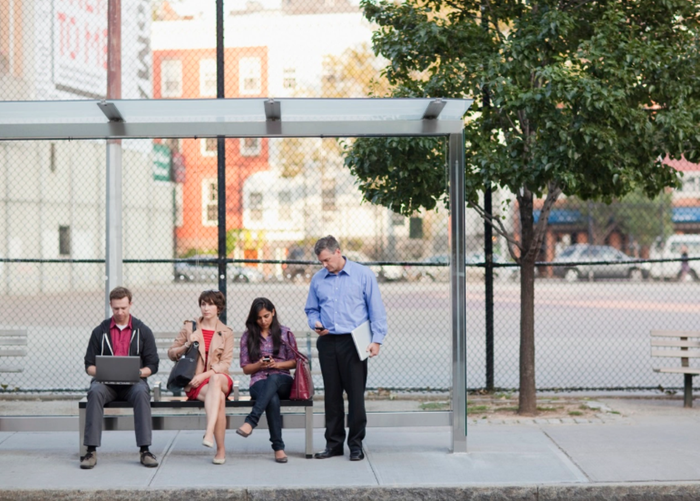How IoT Devices Can Enhance the Connected Customer ExperienceHow IoT Devices Can Enhance the Connected Customer Experience
February 24, 2021

As the COVID-19 pandemic continues to wreak havoc around the world, consumers have put health first as they interact with companies.
“To reduce the risk of infection, people are anxious to minimize physical contact and maximize contactless interactions, and companies are taking note,” according to the Capgemini report, “COVID-19 and the Age of the Contactless Customer Experience.”
The pandemic has affected lifestyles, and consumers now gravitate toward contactless purchasing methods, creating a huge potential for intelligent products enabled by artificial intelligence (AI) and (machine learning) in the market, said Regu Ayyaswamy, senior vice president and global head, Internet of Things (IoT) at Tata Consultancy Services.
IoT Enables Contactless Service
“We are seeing an uptick in demand for AI- and IoT-enabled products, which can be controlled from anywhere, at any time,” Ayyaswamy said.
TCS, for example, delivered an IoT platform for connected pools that enables remote equipment monitoring, predictive and proactive maintenance of pool equipment and helps pool professionals provide customer support from anywhere in the world, he said. It also allows pool owners to remotely control pool settings and even adjust temperature, lighting, etc., through voice commands.
“IoT allows devices to communicate issues to the support team automatically, and engineers can remotely program and resolve issues,” he said.
Service technicians can also remotely program, adjust or fix certain consumer devices, such as thermostats, much like technicians do for enterprise customers. according to Bill Donlan, executive vice president and digital CX/Salesforce at Capgemini.
“Consumers are being enabled similarly [to enterprise customers] as we move to the age of “things” on the Internet,” Donlan said. “These systems are able to self-diagnose, request repairs, request replacement parts, identify and predict usage-related service needs. And the use of past maintenance records and analytics can allow us to predict when service is required.”
Defining IoT fore customer experience can be challenging, as each of the devices that can replicate sense and use a variety of connectivity options, said Hyoun Park, CEO and principal analyst at Amalgam Insights
A Bluetooth camera could be very different from a cellular connected microphone, for instance. In each case, the ability to augment the experience is limited by the quality of the hardware, the bandwidth available in the network, the type of connectivity used, and the accessibility to the outputs of that device, Park said.
“Think of a security camera,” he said “If it lacks the resolution to make out a person’s face, it is functionally useless,” he said. “If the signal can’t be transferred from the device to a screen in a timely manner, the viewer will just see jittery nonsense even if the camera works. If the signal is hacked, this information could be shared with other people. And if the camera output can only be seen on proprietary apps or devices, it reduces the accessibility of the output.”
AI Service Robots
Cheetah Mobile, which manufactures robots, uses IoT to create a connected customer experience at conferences, said Vincent Li, head of global sales and marketing, IoT and robotics at Cheetah Mobile.
In light of prioritizing the health and safety of event attendees, AI service robots — IoT devices embedded with software to connect offline and online scenarios —play a role in conferences by virtually transporting remote participants to event venues via a cloud-based network connection, giving each of the robots IoT capabilities, Li said.
To enable these remote interactions, robotics company OrionStar developed an all-in-one platform that allows the show host, vendors and attendees to interact with and control the robots, according to Li.
Through the virtual conference app, attendees can select the events that they want to attend, book appointments with different vendors and communicate with the vendors during the show. By deploying the exhibition robots, event hosts can guarantee a24/7, consistent experience for attendees: Robots don’t get tired or bored of repeating the same information, Li said.
At the 2020 Beijing International Automotive Exhibition (Auto China), Cheetah Mobile provided online attendees with the chance to vote for the automobiles they wanted to see via its mobile app. Cheetah Mobile’s robots then visited the booths of attendees’ top choices so the remote participants could see the cars.
For on-site attendees, exhibition robots can answer questions, provide food/beverages and offer venue maps — all while remaining contactless, Li said. These robots help event planners and exhibitors provide contactless check-in, event information and venue layout guidance for in-person attendees.
The central potential issue with robots in a conference space is the challenge of voice recognition in noisy environments that may require a combination of voice, AI-driven lip reading, and other context, Parks said.
Also, to simulate human interactions, robots need to understand pointing and facial cues associated with the human desire to choose something. Depending on how robots are set up to understand language, robotic service could be an advantage or a disadvantage, he said.
“If the robots use speech with subtitles and options for multiple languages, they could be superior to human interaction while robots with limited language skills could end up being too frustrating to work with,” Park said.
Self-Diagnosing Speakers
Connected things can gather critical data about the surrounding environment that can then provide important feedback on important changes.
Consider smart speakers, for example, which may be too sensitive in certain environments.
“Everyone has connected speakers, but they are not all able to tolerate water or humidity,” said 451 Research analyst, Sheryl Kingstone.
There are connected speakers that include sensors that monitor the environment, such as ambient humidity and proactively self-diagnose problems, she said.
“So when you move it into the bathroom, all of a sudden it triggers a support call,” Kingstone said. “Then the support person can email the customer saying the humidity levels are too high for the speaker and to check where you’re using [the speaker], because we don’t suggest using it in the bathroom.'”
Sensor data allows the customer service and support team to identify anomalies and proactively reach out to the customer before the speaker shorts out, she said. This could save the customer from having to make a trip to the repair shop.
Smart Inhaler to Manage Asthma
Unmanaged asthma can result in twice as many annual hospitalizations and significantly more medical visits than asthma conditions that are better managed, according to an article in “The Journal of Allergy and Clinical Immunology.”
To help people reduce doctor or emergency room visits, Propeller Health has developed the digital health tool Propeller that enables those with asthma or chronic obstructive pulmonary disease (COPD manage their conditions in partnership with their clinicians.
Propeller sensors attach to patients’ existing inhalers and deliver insights on medication use, symptoms, triggers and environmental factors to the Propeller app on their smartphones, which patients can then share with their clinicians to help inform their treatment plans.
The platform can ingest information about how patients use asthma medication, said Mark Sehmer, the company’s vice president of engineering.
Propeller Health processes the data and provides insights back to the patients via the Propeller app, he said.
“A big part of asthma is that there are all sorts of things that can trigger an exacerbation, from allergies to pet dander, pollen and air quality,” Sehmer said. “So we take those signals and then we use, in some cases, third-party data to help identify what is causing or what led up to that exacerbation and expose that information back to the patient through a mobile application.”
One company providing Propeller with data regarding air quality is Israel-based BreezoMeter, which provides hyperlocal air quality data to businesses. Propeller Health incorporates BreezoMeter’s real-time air quality information to correlate actual medication use and symptom flare-ups with environmental triggers.
The BreezoMeter forecast powers the Propeller app to provide a highly personalized, predictive service that notifies asthma or COPD patients using the Propeller app of their personal asthma forecasts, said Ran Korber, CEO and co-founder of BreezoMeter.
“If, according to our forecast, we recognize that the pollen count might be high at an asthma patient’s home, the Propeller Health app will warn this individual so he can take action ahead of the time,” Korber said. “For example, closing the windows before the pollen gets into the house, turning on his air purifier, or even using his personal inhaler.”
Bringig medical dosing and time-based and location-based information together will have impact, according to Park.
The biggest issue is simply whether the location information is kept in a secure location that a user has access to, he said. But this is an issue that comes up with many apps that ask for location-based information. A second concern is that an app may provide advice that contraindicates direct medical guidance, so medical professionals should understand how to use this app, he said.
“But in general, this sounds like a helpful app to make medical dosing more personalized to individual reactions and situations,” Park saids
Touchless Elevator Operation
To enable consumers to ride elevators without having to touch the panel, Schindler Elevator Corp., the North American operation of the Switzerland-based Schindler Group, has developed the ElevateMe mobile app to enable users to call elevators and select their destinations using smartphones.
Based on Schindler’s Internet of Elevators & Escalators (IoEE) platform, the app works with Schindler Ahead connected elevators. Installation involves a simple upgrade, after which the service can run instantly. Building owners or managers just place the provided QR code stickers on the elevators, and passengers can start operating the elevator via the Schindler ElevateMe app.
The app scans the code, then validates that a customer has scanned the code and is in proximity to the elevator, and therefore authorized to generate the call, said Xris Mason, director of IoEE at Schindler Digital Group.
“The call is sent over the air to the cloud. We’re running an Azure cloud application, where we have the primary processing for the ElevateMe call requests,” he said. “These are then processed and dispatched to our IoT device, which is installed in the building and attached to the elevator group. And this IoT device is communicating directly with our elevator controllers.”
The feedback from customers so far has been “wonderful,” said Kristin Prudhomme, Schindler’s vice president of new construction sales and products.
“This was something that the market was pushing from Schindler,” she said. “As soon as COVID hit, … almost every architect and general contractor and building owner called Schindler and [asked], ‘What COVID solutions do you have’ A lot of them wanted more than just hand sanitizer.”
One of the issues with the application is that QR codes are not widely accepted by consumers here in the U.S., Kingstone said.
“[In addition], it’s just as easy to use antibacterial cleaner in a purse,” she said. “However, it is contactless and studies have shown contactless adoption accelerated finally in the U.S. due to COVID. To have it more widely adopted, I would have expected [near-field communication for ease of use vs. taking time to scan a QR Code.”
The Schindler elevator app looks like an interesting option for touchless elevator rides, but it requires the use of a Schindler app, so the user base is limited, Park said. In addition, the app builders need to think about accessibility so that blind and otherwise disabled users can either hear the app or speak to the app or they will be left out of the ability to use the elevators.
“This app [also looks dependent on 4G cellular networks rather than localized Wi-Fi, Bluetooth or other networks,” Park said. :This is probably OK from a security perspective as long as the elevator IP addresses are not accessible from the outside world, but also may cause issues if cellular signal is unavailable or if there are cellular-related equipment failures in the building.”
COVID-19 Accelerates New Customer Experience Modes
Because of COVID-19, consumers are focusing on ways to stay safe by adopting social distancing and sanitary practices — practices that will likely continue even beyond the pandemic, according to Capgemini.
“As part of this, [consumers] have grown increasingly cautious of touching shared interfaces and objects foreign to them,” according to the Capgemini report. “This major behavioral shift means that, across different sectors, people are looking for touchless practices. Organizations must therefore reassess their customer experience, with a focus on emerging technologies, such as vocal interfaces, facial recognition and mobile-based applications.”
About the Author
You May Also Like








